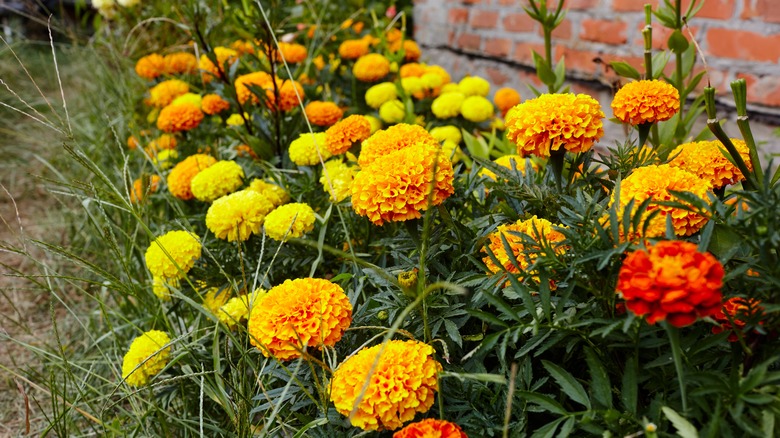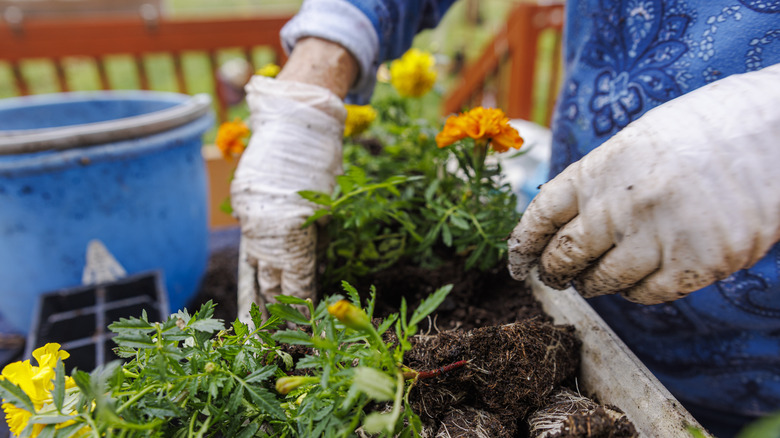The Marigold Varieties You Might Want To Avoid Planting In Your Garden
Marigolds are a wildly popular garden bloom. They're hardy, the bright yellow, orange, and red flowers provide much-needed drama, and there's some evidence to suggest they ward away certain insects. It's easy to think the benefits of planting marigolds in your garden outweigh the potential downsides. But what exactly are those downsides? All Tagetes species — that's the scientific name for marigolds — have the potential to cause skin irritation when brushed up against. The North Carolina Extension Gardener Plant Toolbox notes "Contact Dermatitis" under "Problems" in their entry on the Tagetes species.
What's in the marigold that causes such awful skin irritations? Researchers have long known that the phototoxic thiophenes and sesquiterpene lactones are likely responsible for adverse dermatological reactions, at least in mammals. Experiments with guinea pigs, published in a 1995 issue of Contact Dermatitis, isolated a moderate to strong response from the marigold-derived butenylbithiophene in particular. A 2005 European Commission investigation into the allergic potential of Tagetes erecta, Tagetes minuta, and Tagetes patula extracts and oils declared them unsafe for use in topical cosmetics.
The no-plant list
If you have particularly sensitive family members you worry will wander through your garden beds, you might do well to avoid planting any Tagetes species. If you're less worried, you could get away with simply steering clear of the specific varieties worst for allergies. These include Tagetes tenuifolia (signet or lemon marigold), Tagetes erecta (African or Mexican marigold), Tagetes patula (French marigold), and Tagetes lucida (also known as Mexican marigold in the U.S. or sweet mace in the U.K.).
Tagetes minuta (another African marigold) features on the U.K.-based Royal Horticultural Society (RHS) list of potentially harmful garden plants as a skin irritant. If you really want to dig into the data, the RHS database features over 300 Tageta species with allergen information included. For example, Tagetes erecta gets a warning, while Tagetes patula (another French marigold) doesn't. The world of marigold naming is confusing. Gardeners and nurseries alike use the same common name for more than one cultivar. Those wishing to avoid allergy-inducing marigolds should refer to the scientific name when shopping for plants or seeds.
Precautions for gardeners
Articles on what you need to know before planting or picking marigolds rarely mention the importance of covering up. Wear gardening gloves, eye protection, socks and shoes or boots, pants, and long-sleeved shirts. Marigolds are generally safe for pets. However, if your pet has skin sensitivities, watch them closely when playing around these plants. An allergic reaction from plants — on human and furry family members — resembles a rosy rash that you can't help but scratch, sometimes with blisters or hives.
There are other species of plant in the United States that boast "marigold" as a common name, and it's important not to confuse them with Tagetes cultivars. Some, like the fiery marigold that's the subject of this article, are also potential allergens. The yellow marsh marigold (Caltha palustris) is a native herb with flowers that resemble buttercups. It grows wild in boggy areas, most everywhere but the lower south of the U.S., and is mildly toxic to the skin. The desert marigold (Baileya multiradiata), a yellow-flowered shrub indigenous to the southwestern U.S., is toxic only to goats and sheep. Pot marigolds (Calendula officinalis) look strikingly similar to marigolds of the Tagetes species — so much so that gardeners often confuse the two. Despite the likeness, pot marigolds are safe to touch.


